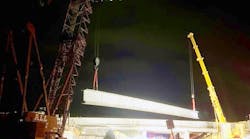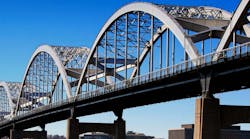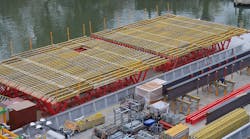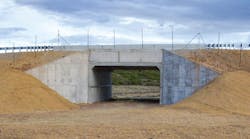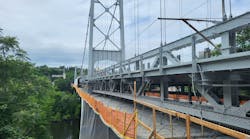“We have a number of different types of structures in the Bay Area,” David Ambuehl, construction manager for Caltrans on the Benicia-Martinez job, told ROADS & BRIDGES. “With all of these signature structures going up, [Caltrans] decided to try to mix it up a bit.”
Being different also meant dealing with the difficult. The challenge of long spans constructed under the cast-in-place balanced cantilever method, seismic considerations and environmental and Coast Guard issues all had to be met head-on by prime contractor Kiewit Pacific Co. Those obstacles, plus the enormous size of the project (8,790-ft bridge at a price of $800 million) made the Benicia-Martinez Bridge a clear No. 1 choice on this year’s ROADS & BRIDGES Top 10 Bridges list.
“We have had a lot of hurdles to get over, but we work really well together, and with each hurdle cleared we certainly feel better about the progress,” said Ambuehl.
The hurdles stood tall early in this race. First there was the attempt to perfect the concrete mix design, which demanded a 10,000-psi compressed strength. Ambuehl said it took well over 100 formulas before the ideal one was found. Then came the location of the bridge. Caltrans wanted to build to the west of the existing steel structure. However, ship traffic due to oil refineries in the area and difficulties purchasing right-of-way flipped the new concrete bridge over to the east side.
Long span lengths forced another issue. The maximum span length of the Benicia-Martinez is 660 ft long, and if it was any longer Caltrans would have been forced to go with a different bridge type. A heavy dose of post-tensioning and segment depth at the pier tables helped resolve the challenge. The segments are 40 ft deep at the tables, and thin to 12 ft deep at mid-span.
The Benecia-Martinez Bridge is designated a lifeline structure in the Bay Area, which means it needs to be open to emergency traffic 24 hours after a major earthquake. To keep the span structurally sound, 17 footings are drilled 250 ft deep, the final 100 ft in bedrock. The bedrock, however, was prone to fracture during the drilling process, which created another one of those hurdles.
“When you started to drill, you could experience cave-ins because the highly fractured rock would fall apart,” said Ambuehl.
After drilling a series of eight or nine piles, crews built a concrete platform that mounted on the piles and brought in a rotator rig. The rig grabbed a steel shell pile, which was about a foot smaller than the 8-ft-diam. piles and had teeth on the end of it, and drove it to the bottom of the foundation.
“They would spin it all the way to the bottom and were then able to put their cage inside that shell, and as they poured the concrete the steel shell was pulled out,” explained Ambuehl.
Lightweight concrete used to form the superstructure, the extra post-tensioning and midspan hinges also make the bridge seismic-tough.
As of mid-October, 344 of the 345 segments were cast. The contractor still had six closures left. Once the closures are executed, the bridge deck will be finished. To avoid any imperfections, the deck was poured extra thick so the contractor could come in and grind it down to a smooth finish. The bridge should be open to traffic in the summer of 2007.
Location: Martinez, Calif.
Cost: $800 million
Length: 1.4 miles
Type: Cast-in-place balanced cantilever
Designers: T.Y. Lin International/CH2M Hill
Owner: Caltrans
Contractor: Kiewit Pacific Co.


